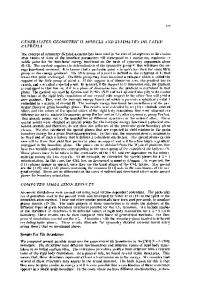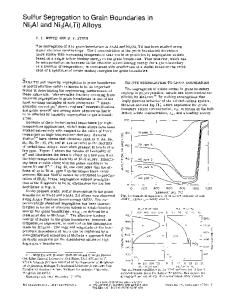Fracture Strength of Grain Boundaries in Ni 3 Al
- PDF / 612,816 Bytes
- 6 Pages / 612 x 792 pts (letter) Page_size
- 57 Downloads / 406 Views
Fracture Strength of Grain Boundaries in Ni3Al Jian-Qing Su, M. Demura and T. Hirano National Research Institute for Metals, 1-2-1 Sengen, Tsukuba, Ibaraki 305-0047, Japan ABSTRACT The fracture strength of grain boundaries in Ni3Al was quantitatively measured by performing tensile tests on miniature bicrystal specimens with various grain boundary types. A fairly good relationship between fracture mode, fracture strength and Σ value was established. The Σ1, Σ3 and Σ9 boundaries were found to be strongly crack-resistant but the adjacent bulk fractured. In contrast, Σ5, Σ7, Σ11, Σ13 and random boundaries were found to be less crack-resistant and fractured at lower stresses than the fracture strength of the bulk. In the latter case, the fracture strength of the Σ11 and Σ13 boundaries was higher than that of the Σ5 and Σ7 boundaries. Most random boundaries were as weak as the Σ5 and Σ7 boundaries, but some exhibited high fracture strength comparable to that of the Σ11 and Σ13 boundaries. INTRODUCTION Previous work suggests that fracture behavior of grain boundaries in Ni3Al is likely to depend on grain boundary type. For the first time, Hanada et al. found no cracks along Σ1 (low angle) and Σ3 boundaries in bent specimens of recrystallized stoichiometric Ni3Al, indicating that these two boundaries are crack-resistant compared to the other boundaries [1]. Later, Lin and Pope confirmed this tendency in bent specimens of melt-spun Ni-24.8at%Al-0.2at%Ta ribbons [2]. These studies qualitatively indicate a dependence of grain boundary strength on Σ value. Therefore, it is necessary to establish a quantitative relation between the fracture properties of grain boundary and Σ value. However, it is not easy to measure the fracture strength, primarily because of the difficulty in preparing bicrystal tensile specimens with various grain boundary types. So far there is no systematic measurement of the fracture strength as a function of Σ value. In our previous study, we developed a technique for fabricating large-grained sheets of binary stoichiometric Ni3Al by skin pass cold-rolling and subsequent recrystallization [3]. This technique enabled us to prepare bicrystal tensile specimens, even though they were small in size. The objective of this study was to establish a relationship between fracture properties and Σ value using these miniature bicrystal specimens.
EXPERIMENTAL Large-grained sheets of binary stoichiometric Ni3Al (Ni-24.5 at% Al) whose grain boundaries traversed perpendicularly through the sheet were fabricated by recrystallization [3]. Miniature bicrystal tensile specimens having a gauge section of 0.812 mm were cut from the sheets by ultrasonic cutting machining. The grain boundary was arranged normal to the tensile axis. Orientations of the bicrystal specimens were measured by Laue X-ray back reflection. The Σ values of the grain boundaries were calculated according to Brandon’s criterion N6.10.1
[4]. If the deviation angle ∆θd from an exact CSL relation was smaller than the critical value ∆θc=15/Σ1/2, i.e. ∆θd /
Data Loading...











